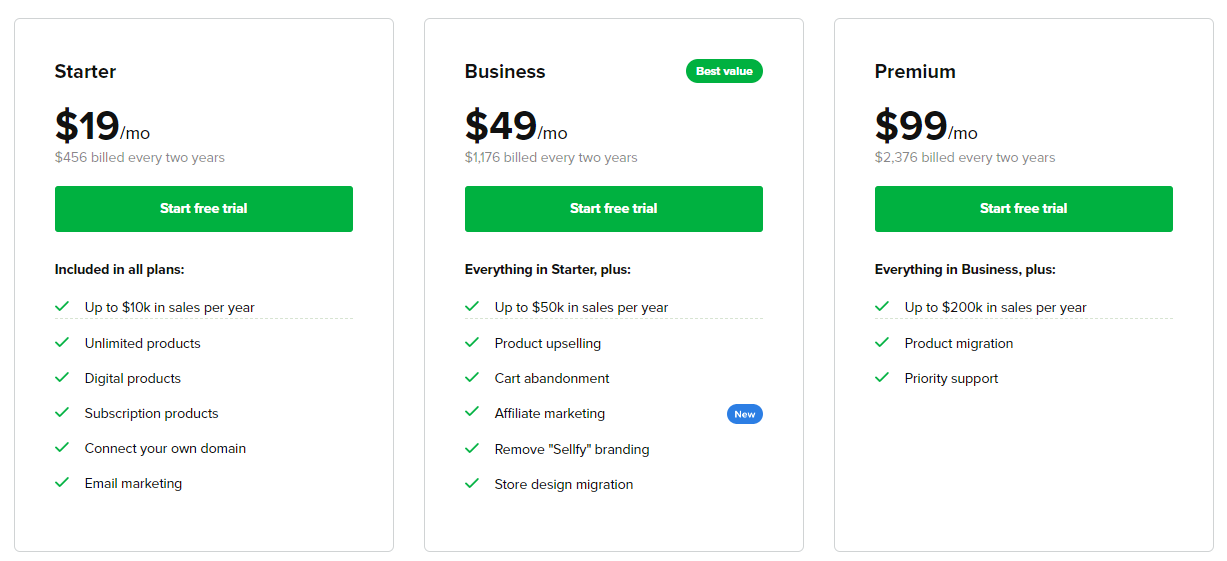My content is reader-supported by awesome people like you. Which means I could earn a commission. Learn more here!
You’re ready to turn your passion into profit, but now comes the tough decision: Shopify or Sellfy?
Both platforms promise to make selling online easy, but which one actually fits your needs?
Maybe you’re an artist looking for a simple way to sell digital downloads, or perhaps you’re dreaming of launching a full-fledged eCommerce brand.
The last thing you want is to spend time (and money) on the wrong platform.
Don’t worry, I’ve got you covered.
In this guide, we’ll break down Shopify vs. Sellfy, comparing features, pricing, and ease of use so you can confidently choose the best platform for your business.
How I Like To Test These Platforms
| Ease of use | Is it easy to sign up for, and is there guidance to not fail |
| Customer Support | I gotta see this somehow |
| Tools it offers (Marketing, SEO, Product Tools) | We need tools without venturing out to other companies all the time |
| 25-point feature checklist | It can be my secret sauce. It includes other areas but it lets me know how it’s doing. |
| Actual customer user ratings | I set out and find actual other users that use this product for their business. These can be on review sites, forums, or my reader’s opinions to give you an idea. |
| Testing project | I try to run it through a project I feel good about |
| Overall rating | After compiling data I give it a rating. |
How I Like To Test These Platforms
| Ease of use | Is it easy to sign up for and is guidance there to not fail |
| Customer Support | I gotta see this somehow |
| Tools it offers (Marketing, SEO, Product Tools) | We need tools without venturing out to other companies all the time |
| 25-point feature checklist | It can be my secret sauce. It includes other areas but it lets me know how it’s doing. |
| Actual customer user ratings | I set out and find actual other users that use this product for their business. These can be on review sites, forums, or my reader’s opinions to give you an idea. |
| Testing project | I try to run it through a project I feel good about |
| Overall rating | After compiling data I give it a rating. |
Ratings Breakdown Summary
| Shopify | Sellfy | |
| Ease of use | 4.6 out of 5 | 4.5 out of 5 |
| Customer Support | 4.9 out of 5 | 4.5 out of 5 |
| Tools it offers (Marketing, SEO, Product Tools) | 4.6 out of 5 | 4.4 out of 5 |
| 25-point feature checklist | 4.6 out of 5 | 4.4 out of 5 |
| Testing project | 4.6 out of 5 | 4.6 out of 5 |
| Customer User Rating Score | 4.5 out of 5 based on 6,280 customer users | 4 out of 5 based on 43 Users |
| Overall rating Of Shopify | 4.63 out of 5 | 4.4 out of 5 |
Try Shopify Free or Try Sellfy Free
Ease of Use – I mean if I can do it you can
Shopify and Sellfy are both easy to set up and manage, even for beginners.
Shopify has a simple step-by-step setup process that allows you to create your online store in just a few minutes.
The dashboard is intuitive and easy to navigate.
You don’t need any coding skills as Shopify offers a range of professional themes and templates.
With just a few clicks, you can customize the design, add products, adjust settings, and publish your store.
Shopify also has a mobile app so you can manage your store on-the-go.
Sellfy is just as easy for beginners.
It uses a drag-and-drop builder to create your online store.
There are numerous templates to choose from across various niches that you can customize with your brand colors, fonts, images, and more.
Adding products is simple with bulk upload options.
And with automated sales tax calculations and seamless payment integrations, you don’t have to worry about the technical back-end work.
Everything is streamlined for simplicity.
Both platforms are designed for user-friendliness.
Even those with no eCommerce experience can launch and manage a professional online store with Shopify or Sellfy.
The intuitive dashboards and customizable templates allow you to focus on your products and customers rather than tackling a complex setup process.
Costs: Shopify vs Sellfy Pricing Plans Breakdown
Here’s an overview of the pricing for each:
Shopify Pricing Plans
- Shopify Starter – $5/month
- Shopify Basic – $29/month
- Shopify – $79/month
- Advanced Shopify – $299/month
Shopify also charges transaction fees of 2.9% + 30¢ per transaction.
There are ways to get discounted rates through Shopify Payments.
With Shopify, you don’t pay extra for features like an online store, shopping cart, unlimited products, 24/7 support, and more.
Everything is included in their monthly pricing plans.
Sellfy Pricing Plans (Discounts when paid annually or for two years)
- Starter – $29 Monthly
- Business – $79 Monthly
- Business – $159 Monthly
In addition to monthly fees, you will need to cover payment processing fees of PayPal or Stripe (typically 2.9% + 30¢) depending on which payment gateway you choose.
Sellfy’s free plan is limited to 10 products and basic store features.
You need a paid plan to access features like custom domains, coupons, taxes, and more.
Overall, Shopify’s pricing is more straightforward while Sellfy has some hidden costs through commissions and feature limitations on lower tiers.
Store Design and Customization
Both Shopify and Sellfy offer themes and customization options to help you design an attractive online store that matches your brand.
Shopify has 10 free themes and around 70 premium themes costing $140-180 on average.
The themes are modern, minimalist and customizable, with options to change colors, fonts, add sections etc.
You can also edit HTML/CSS code for advanced customization.
Sellfy has a smaller selection of around 30 themes ranging from free to $59.
The focus is more on simplicity and ease of use rather than advanced design features.
Themes are still professional-looking but have fewer customization options compared to Shopify.
For maximum design flexibility, Shopify is better.
It has a much wider range of both free and paid themes, plus greater control over customizing theme design and layout.
Shopify also supports multi-language sites out of the box.
Sellfy is better suited for anyone wanting a simple store with a clean, basic design.
The themes are easy to use with little coding knowledge required.
But you have less control over colors, fonts, sections, etc compared to Shopify.
Overall Shopify offers greater design freedom and customizability.
Sellfy focuses more on simplicity and ease of use over advanced design features.
Those needing premium branding and customization should choose Shopify, while Sellfy is better for basic stores.
Marketing and SEO Features (You gotta have them)
Both Shopify and Sellfy provide built-in tools and features to help merchants market their online stores and optimize for search engines.
Shopify
-
Shopify offers a number of marketing apps and integrations, including email marketing, social media scheduling, loyalty programs, and more. Shopify’s app store has over 6000 apps to help merchants with marketing.
-
Built-in SEO features in Shopify include custom metadata fields, SEO-friendly URLs, schema markup, alt text automation, and sitemap generation.
-
Shopify also provides recommendations to improve SEO through its store audits. It offers SEO guides and webinars for merchants.
Sellfy
-
Sellfy has minimal built-in marketing features but integrates with MailChimp for email marketing campaigns.
-
For SEO, Sellfy allows editing metadata like page titles and descriptions. It also provides alt text automation for product images.
-
However, advanced SEO features like XML sitemaps are missing. There is limited SEO guidance available compared to Shopify’s resources.
-
Sellfy merchants may need to rely more on external apps and their own expertise to optimize marketing and SEO efforts.
Overall, Shopify provides significantly more built-in tools, integrations, and guidance for marketing and SEO optimization out of the box compared to Sellfy’s minimal capabilities.
Sales Channels (Can’t stick to one method)
Shopify and Sellfy both provide their users with the ability to sell through multiple sales channels beyond their own website.
This enables sellers to access a larger audience and increase sales.
Selling on Social Media
Shopify offers integration with Facebook and Instagram shops, allowing sellers to easily sell directly through their social media presence.
Sellfy does not currently have built-in social selling features.
Online Marketplaces
Shopify provides integration with Amazon, eBay, Facebook, Instagram, and more, enabling sellers to list their products on these popular online marketplaces.
Sellfy does not offer marketplace integrations.
Brick and Mortar Stores / POS
Shopify offers a solution for this built right in while Sellfy you would have to integrate another platform in.
Additional Channels
Shopify allows selling through buy buttons on blogs, links in emails, and other external channels.
Sellfy focuses primarily on selling through its own platform.
In summary, Shopify provides more options and seamless integration for selling through multiple channels beyond a seller’s own website.
Sellfy is more limited, focusing on selling directly through its platform.
Payment Options Set You Up for Success
Selling online means accepting payments digitally.
Shopify and Sellfy make the payment process easy by integrating with leading payment gateways and providing fraud protection.
Shopify
-
Shopify Payments is built-in, letting you accept credit cards with competitive transaction rates.
-
Shopify offers Fraud Analysis to review orders and catch fraud. Chargeback Protection also helps protect you from costly chargebacks.
-
Over 100 payment gateways integrate with Shopify including major players like PayPal, Stripe, and Square. Shopify charges transaction fees for external gateways.
Sellfy
-
Sellfy integrates with PayPal and Stripe to accept payments. There are no extra transaction fees.
-
Sellfy has FraudSentry which uses AI to detect fraudulent activities.
-
Sellfy processes payments directly so there are no extra payment gateway fees.
Both Shopify and Sellfy make accepting payments easy and secure.
Shopify offers more payment options but charges extra fees.
Sellfy focuses on PayPal and Stripe with no extra fees.
Ultimately, both platforms set sellers up for success when it comes to getting paid.
Scalability of these 2 eCommerce platforms
Both Shopify and Sellfy offer scalable solutions that can grow with your business.
However, Shopify generally has more robust scalability and can better accommodate high-volume sellers.
Ability to Scale from Small to Large Business
Shopify offers a wider range of pricing plans, from the $29/month Basic Shopify plan to the $2,000/month Shopify Plus Plan.
This allows you to easily scale up as your business grows.
Shopify also has more advanced features like automated shipping/fulfillment and the Shopify Capital business financing service.
Sellfy, on the other hand, is better suited for small businesses and creators.
Their plans go up to $299/month for the Pro plan, supporting up to 10,000 orders per month.
However, Sellfy may not be ideal if you need advanced inventory management and order volumes in the hundreds of thousands.
In summary, Shopify offers more seamless scaling from a small business to a mid-market or enterprise seller.
Sellfy works for early-stage businesses but cannot accommodate extremely high order volumes.
So Shopify is better if you anticipate becoming a high-volume seller.
Support and Resources
Both Shopify and Sellfy offer a variety of support resources to help merchants.
Shopify
-
Shopify provides 24/7 support via live chat, email, and phone. Support reps are knowledgeable and quick to respond.
-
Extensive help center with guides, FAQs, and tutorials covering everything from setting up your store to marketing and selling.
-
Active community forums where merchants can ask questions and get advice from other Shopify users.
-
Shopify U provides free online courses and certifications to help merchants learn eCommerce best practices.
-
Shopify also offers paid services like Shopify Experts to help optimize stores.
Sellfy
-
Sellfy has email support available, but no live chat or phone options. Response times can vary.
-
Help center provides basic setup guides, FAQs, and tutorials. Not as comprehensive as Shopify’s.
-
Community forums exist but not widely used compared to Shopify’s forums.
-
No free educational courses like Shopify U, but they do offer paid 1-on-1 consulting.
-
Less formal support ecosystem compared to Shopify. Relies more on self-service content.
-
Shopify definitely provides more extensive customer support and educational resources. But Sellfy’s options may suit smaller merchants.
FAQ On Shopify & Sellfy
What is the main difference between Shopify and Sellfy?
Shopify and Sellfy are both e-commerce platforms, but they cater to different needs. Shopify is a comprehensive platform that offers a wide range of features and tools for building and scaling an online store. Sellfy, on the other hand, is more focused on selling digital products like ebooks, music, videos, and artwork. The main difference lies in the target audience and the types of products you intend to sell.
Can I sell physical products on both Shopify and Sellfy?
Yes, you can sell physical products on both platforms. However, Shopify is better equipped for selling a larger range of products, including physical goods. It provides extensive inventory management capabilities, shipping integrations, and support for various payment options. Sellfy, on the other hand, is primarily optimized for selling digital products, though it does offer some basic features for selling physical items as well.
Which platform offers more design customization options?
When it comes to design customization, Shopify provides more flexibility and control. It offers a wide selection of professionally designed themes and allows extensive customization through its theme editor, HTML, and CSS. Sellfy also offers customizable storefronts and product pages, but the options are more limited compared to Shopify.
Do both platforms support multi-channel selling?
Yes, both Shopify and Sellfy support multi-channel selling, but in different ways. Shopify offers robust integrations with marketplaces like Amazon, eBay, and social media platforms, allowing you to sell your products in multiple channels. Sellfy, however, is more focused on direct sales through your own storefront, although it does provide some integrations with external platforms.
Can I use my own domain name with Shopify and Sellfy?
Yes, both platforms allow you to use your own domain name. Shopify provides the option to purchase a custom domain directly through their platform or connect an existing domain. Sellfy also offers the ability to use your own domain name by updating your DNS settings.
Which platform offers better marketing and SEO features?
In terms of marketing and SEO features, Shopify is the clear winner. It offers a wide range of built-in marketing tools, such as discount codes, email marketing, and social media integrations. Shopify also has a robust SEO infrastructure with customizable meta tags, URL structure, and optimized site speed. Sellfy, while it provides some basic marketing features, is less comprehensive in this regard.
What about payment options and transaction fees on Shopify and Sellfy?
Shopify gives you the flexibility to choose from over 100 payment gateways or use their native payment gateway, Shopify Payments. Shopify Payments has competitive transaction fees, and if you use it, Shopify waives transaction fees altogether. Sellfy predominantly uses PayPal as its payment gateway, and its transaction fees vary depending on your chosen PayPal plan and location.
Which platform offers better customer support options?
Both Shopify and Sellfy offer customer support options. Shopify provides 24/7 support through phone, live chat, and email. They also have a comprehensive help center and an active community forum. Sellfy offers support via email, with response times usually within 24 hours. They also have an extensive knowledge base to help you find answers to common questions.
Which platform is more suitable for beginners?
Shopify is often considered more beginner-friendly due to its user-friendly interface, intuitive tools, and extensive documentation. It provides step-by-step guidance for setting up your online store. Sellfy is also relatively easy to use but may have a slightly steeper learning curve for beginners unfamiliar with e-commerce platforms.
Try Shopify Free or Try Sellfy Free
My Verdict On Comparing These Two
I think either one is going to work well to get started and create that simple store.
Sellfy is going to be solid for that content creator selling products or digital products.
Shopify is going to cover all your bases.
Overall, Shopify is going to be the better choice, especially long term because they have a proven ecosystem that can grow with you.
Meaning you won’t have to migrate away from Shopify because they have a system in place that will work with you.








Leave a Reply